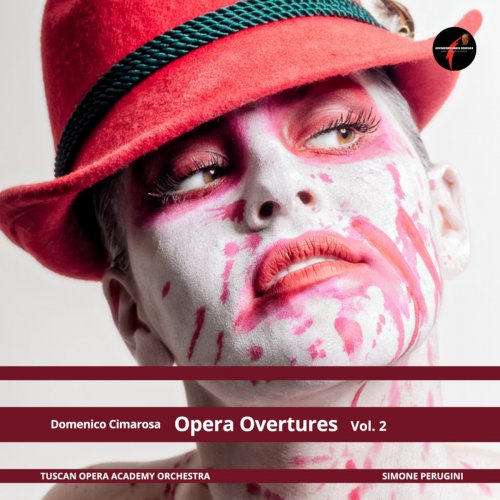
Simone Perugini - Cimarosa: Opera Overtures, Vol. 2 (2021)
BAND/ARTIST: Simone Perugini
- Title: Cimarosa: Opera Overtures, Vol. 2
- Year Of Release: 2021
- Label: Tuscan Opera Academy "Domenico Cimarosa"
- Genre: Classical
- Quality: FLAC (tracks)
- Total Time: 54:42 min
- Total Size: 278 MB
- WebSite: Album Preview
Tracklist:
01. Le astuzie femminili: Overture
02. Il capriccio drammatico: Overture
03. La finta frascatana: Overture
04. Il convito: Overture
05. Giunio Bruto: Overture
06. I due supposti Conti: Overture
07. La villana riconosciuta: Overture
08. Giannina e Bernardone: Overture
09. Gli Orazi e i Curiazi: Overture
10. Il faligname: Overture
01. Le astuzie femminili: Overture
02. Il capriccio drammatico: Overture
03. La finta frascatana: Overture
04. Il convito: Overture
05. Giunio Bruto: Overture
06. I due supposti Conti: Overture
07. La villana riconosciuta: Overture
08. Giannina e Bernardone: Overture
09. Gli Orazi e i Curiazi: Overture
10. Il faligname: Overture
Domenico Cimarosa (1749-1801) - OPERA OVERTURES, VOL. 2 - Content: Le Astuzie femminili; Il Capriccio drammatico; La Finta frascatana; Il Convito; Giunio Bruto; I Due supposti Conti; La Villana riconosciuta; Giannina e Bernardone; Gli Orazi e i Curiazi; Il Faligname. LINER NOTES: Domenico Cimarosa (Aversa, December 17, 1749 - Venice, January 11, 1801) was, together with Giovanni Paisiello, the most important exponent of the last period of the so-called Neapolitan School and was one of the most famous composers, celebrated and paid before the advent of Rossini. His comic and serious operas met with extraordinary successes and constant replicas in all theaters of Europe. He began his career as an opera performer initially making his way into Neapolitan theaters (the Teatro dei Fiorentini, the Nuovo Sopra Toledo mainly up to, later on, arriving at the Royal Theater of San Carlo). The successes reaped in the Kingdom of Naples, combined with the great esteem and the feeling of deep friendship that bound him to the powerful Roman cardinal Ercole Consalvi, they opened the doors to him for the progressive conquest of the theaters in the center-north of the peninsula: the Valle di Roma, the San Samuele and, later, La Fenice theatre in Venice where his works achieved a never-failing success. The progressive and unstoppable conquest of the Italian theaters brought Cimarosa's fame beyond the European borders, so much so that he was appointed by Tsarina Catherine II, in 1787, Court Composer and Music Teacher of the Royal Chamber of Petersburg, a position he held until 1791. After completing his Russian post, the musician, on the way back to Naples , who undertook with his second wife Gaetana Pallante, with his eldest son Raffaele (born of his first wife Costanza Suffi Pallante) and with his second son Paolo, born during his stay in St. Petersburg, he spent three years in Vienna where, commissioned by Emperor Leopold II, he composed for the Burghteater Il Matrimonio Segreto and Amor rende sagace. Returning to Naples at the end of 1793, he resumed his career in Italy between Naples and Rome until 1799, the year in which, despite himself, he was involved in the revolutionary movements of the Neapolitan capital. The musician adapted his own piece from the serious opera Achille all'Assedio di Troia, composed a few years earlier for the Argentina theater in Rome, to the new verses of Luigi Rossi transforming it into the official hymn of the Republic. The ferocious Bourbon repression, which led to the murder of all the intellectuals and artists who had joined the ephemeral Neapolitan Republic, while avoiding the composer's death sentence, did notsaved from arrest. The musician, in fact, had become disliked by Ferdinand IV not so much for having participated, with the performance of his own republican anthem, in the ceremony of raising the tree of Liberty, but rather for having composed, with a whirling about-face, a cantata celebratory for the restoration of the monarchy. In addition, in the libretto of this cantata, the musician continued to boast the title of "Maestro di Cappella in the current service of His Majesty", despite the musical services rendered to the Neapolitan Republic had automatically made his previous assignments expire. What aroused the anger of the king was, most likely, the unforgivable setback of the betrayal by a character who had a public and official role in the Bourbon court. Excess of zeal, Artemisia. Fate would have it that just a few days after arriving in Venice and just before being able to complete the score of the opera, the musician died due to sudden complications due to a tumor in the lower abdomen that had plagued him for years. Cimarosa died in Venice, inside his residence in Palazzo Duodo - at the time used as a hotel - on 11 January 1801.
Year 2021 | Classical | FLAC / APE
As a ISRA.CLOUD's PREMIUM member you will have the following benefits:
- Unlimited high speed downloads
- Download directly without waiting time
- Unlimited parallel downloads
- Support for download accelerators
- No advertising
- Resume broken downloads


